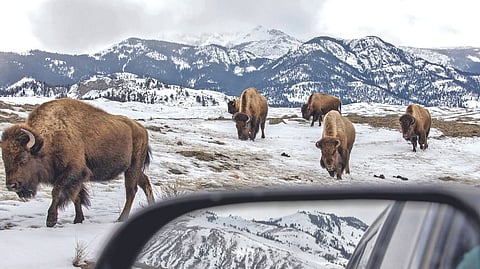Historical culling: Mass Yellowstone hunt kills 1,100 bison
WASHINGTON: An unusually harsh winter that buried Yellowstone National Park under a heavy blanket of snow and ice this year pushed a large portion of the park’s bison herd down to lower elevations and out of the park in search of milder climes and food. Many were stopped from migrating even farther. For four months, state and federal officials have sanctioned a hunt of the shaggy, humped animals that delight millions of tourists and are a centrepiece of Native American culture and history.
Officials said they had no choice but to approve the lengthy culling of the roughly 6,000-member herd as the animals instinctually cross the park boundary onto other public land primarily to the north in Montana’s Paradise Valley, but also west of the park. It is part of a strategy to prevent them from getting near livestock, because some 60 percent of the bison herd carries a disease, brucellosis, that could infect cattle and cause cows to abort their calves. But in the last several weeks, the scope of the hunt, conducted mainly by members of eight Indigenous tribes, along with other park control measures, has generated more criticism than previous hunts.
As the culling winds down, the record-breaking number of bison removed from Yellowstone’s herd has climbed to more than 1,530 — including hundreds of pregnant females that would have soon been giving birth. Hundreds more were sent out of the park — some to slaughterhouses and about 285 to a quarantine site where they will be held to determine if they are disease-free. The healthy ones will be sent to homes on Native American lands elsewhere.
Yet another estimated 800 have been captured and held to protect them from the hunt. Government officials and conservation groups have wrestled with ways to manage the annual migration for decades. “It’s probably the single-most challenging wildlife issue in Yellowstone,” Cam Sholly, the park superintendent, said in an interview.
“The bison is the only species we constrain to a boundary.” It’s a complex management scenario. Once the bison cross an invisible national park boundary and wander into Montana to the north and west on national forest land, they become the responsibility of the state. Under historic treaties bestowing the rights to take buffalo, members of the Nez Perce, Blackfeet, Confederated Tribes of the Umatilla Reservation, Northern Arapaho, Confederated Salish and Kootenai Tribes, the Crow and Shoshone-Bannock Tribes traveled to the region and harvested nearly 1,100 bison. “It’s a very cultural and spiritual endeavor and brings our families together,” said Jeremy Red Star Wolf, of the Confederated Tribes of the Umatilla Indian Reservation. “And it gives us an opportunity to talk about who we are and where we come from.”
About 90 were shipped to slaughter facilities, and 75 were killed by other hunters. “We don’t want to see this many bison taken out of the population in normal years,” Sholly said. “But we have had three years of very light migration out of the park. This is one of the first major migrations out of the park for a considerable amount of time.” Recent studies indicate that the population should not be reduced to fewer than 3,500, Sholly said, to ensure genetic diversity. With a new calf crop this spring, the population should be about 5,000, he estimated.
Robbins is a journalist with NYT©2023
The New York Times
Visit news.dtnext.in to explore our interactive epaper!
Download the DT Next app for more exciting features!
Click here for iOS
Click here for Android

